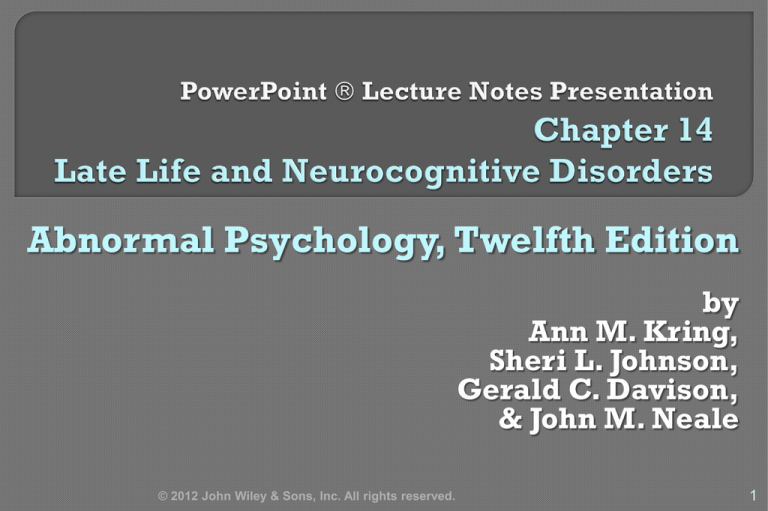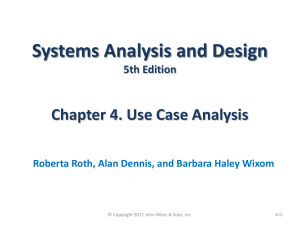
Abnormal Psychology, Twelfth Edition
by
Ann M. Kring,
Sheri L. Johnson,
Gerald C. Davison,
& John M. Neale
© 2012 John Wiley & Sons, Inc. All rights reserved.
1
Chapter
14: Late Life and Neurocognitive
Disorders
I. Aging: Issues and Methods
II. Psychological Disorders in Late Life
Copyright © 2012 John Wiley & Sons, Inc. All rights reserved.
2
In
U.S., many people dread aging
• Elderly not revered as in other cultures
When
are we old?
• Society arbitrarily sets old as over 65
• Young-old: 65-74 years, old-old: 75-84, oldest-old: 85+
2001
census
• 12.4% or 35 million individuals were 65 or older
© 2012 John Wiley & Sons, Inc. All rights reserved.
3
© 2012 John Wiley & Sons, Inc. All rights reserved.
4
Aging involves inexorable cognitive decline
• Severe cognitive problems do not occur for most
Mild declines are common
Late life is a sad time and most elderly are depressed
• Older individuals report less negative emotion than younger
people
More brain activation in key areas when viewing positive images
Late life is a lonely time
• Some less likely to develop new friendships
• Social selectivity
As we age, we focus on the interpersonal relationships that matter most
to us
Older people lose interest in sex
• Sexual activity does not decrease from mid-to late life for most
people
© 2012 John Wiley & Sons, Inc. All rights reserved.
5
Problems multiply with age
• physical decline and disabilities
• sensory and neurological deficits
• loss of loved ones
• social stresses such as stigmatizing attitudes towards elderly
• Eighty percent of elderly people have at least one major medical condition
Sleep disturbances increase with age
• Insomnia
• Sleep apnea
Medical treatment
• Chronic problems instead of curable disorders
• Polypharmacy: Practice of prescribing multiple drugs to patients
• Psychoactive drugs usually tested on younger participants
© 2012 John Wiley & Sons, Inc. All rights reserved.
6
© 2012 John Wiley & Sons, Inc. All rights reserved.
7
Cross-sectional
studies
• Researcher tests different age groups at one point in
time
• Fails to provide information about how people change
over time
Longitudinal
studies
• Researcher retests the same group of people with the
same measures at different points in time
May extend over several years or decades
• Attrition a potential problem
Selective mortality can lead to biased sample
© 2012 John Wiley & Sons, Inc. All rights reserved.
8
© 2012 John Wiley & Sons, Inc. All rights reserved.
9
Most
elderly do not have cognitive
disorders
• Prevalence has decreased over last 15 years
Dementia
• A deterioration of cognitive function
Delirium
• A state of mental confusion
© 2012 John Wiley & Sons, Inc. All rights reserved.
10
Deterioration
of cognitive function
• Impaired social and occupational functioning
• Progresses over time
Begins with difficulty remembering recent events
Deficits
can be detected before impairment
becomes obvious
Mild cognitive impairment develop slowly
DSM-5 proposes two categories, differentiated by
ability to live independently:
• Mild neurocognitive disorder (mild cognitive impairment)
• Major neurocognitive disorder (dementia)
© 2012 John Wiley & Sons, Inc. All rights reserved.
11
© 2012 John Wiley & Sons, Inc. All rights reserved.
12
Minor cognitive decline from previous levels in one or more domains based on both of the
following:
o
Concerns of the patient, a close other, or a clinician
o
Neurocognitive performance below appropriate norms (i.e., between the 3rd and 16th
percentile) on formal testing, or equivalent clinical evaluation.
The cognitive deficits do not interfere with independence (i.e., tasks such as paying bills or
managing medications), even though greater effort, compensatory strategies, or
accommodation may be required to maintain independence.
The cognitive deficits do not occur exclusively in the context of a delirium and are not due
to another psychological disorder
© 2012 John Wiley & Sons, Inc. All rights reserved.
13
Evidence of significant cognitive decline from previous levels in one or more domains
based on both of the following:
o
Concerns of the patient, a close other, or a clinician
o
Neurocognitive performance below the 3rd percentile on formal testing, or equivalent
clinical evaluation.
The cognitive deficits interfere with independence
The cognitive deficits do not occur exclusively in the context of a delirium and are not due
to another psychological disorder
© 2012 John Wiley & Sons, Inc. All rights reserved.
14
Described by Alois Alzheimer in 1906
Irreversible brain tissue deterioration
• Death usually occurs within 12 years
Usually begins with
• Difficulty remembering recent events
• Learning new material
• Irritability
As disease progresses
• Language problems intensify, including word-finding
• Disorientation
Time, place, and identity confusion
• Agitation
• Depression
© 2012 John Wiley & Sons, Inc. All rights reserved.
15
Plaques
• β-amyloid protein deposits
• Primarily found in frontal cortex
Neurofibrillary tangles
• Protein filaments composed of tau in axons of neurons
• Primarily found in hippocampus
Measured using PET scans
Plaques most dense in frontal cortex; tangles most dense in
hippocampus
Loss of synapses for acetylcholinergic (Ach) and glutaminergic
neurons
• As neurons die, atrophy of cerebral and entorhinal cortices and hippocampus
• Enlargement of ventricles
© 2012 John Wiley & Sons, Inc. All rights reserved.
16
Genetic factors
• Heritability 79%
• ApoE4 allele: Gene on chromosome 19
Having one E4 allele increases risk by 20%
Having two E4 alleles increases risk substantially more
Related to over-production of beta-amyloid plaques, loss of neurons in the
hippocampus, and low glucose metabolism in cerebral cortex
Environmental factors
• Smoking, being single, low social support, and depression related to
greater risk of developing Alzheimer’s
• Mediterranean diet, exercise, education, and cognitive engagement
predict a lower risk
e.g. solving crossword puzzles, reading the newspaper daily
• Cognitive reserve
Use alternative brain networks to compensate for disease
© 2012 John Wiley & Sons, Inc. All rights reserved.
17
© 2012 John Wiley & Sons, Inc. All rights reserved.
18
Loss of neurons in frontal and temporal
• Memory not severely disrupted
Impairment of executive functions
• Planning
• Problem solving
• Goal-directed behavior
Difficulty recognizing and regulating
lobes
emotion
• Much more profound impact than Alzheimer’s
Caused by multiple genetic
• Pick’s Disease
• High levels of tau proteins
© 2012 John Wiley & Sons, Inc. All rights reserved.
pathways
19
Typically
results from stroke (cardiovascular)
• Clot forms and impairs circulation
• Cells die
Risk
factors
• Smoking, high LDL cholesterol, high BP
Symptoms
can vary greatly, depending upon
location of strokes
© 2012 John Wiley & Sons, Inc. All rights reserved.
20
Two subtypes
• With Parkinson’s
• No Parkinson’s
Symptoms similar
to Parkinson’s and
Alzheimer’s diseases
• Shuffling gait
• Loss of memory
Symptoms differ in that DLB patients have:
• Fluctuating cognitive symptoms
• Prominent visual hallucinations
• Intense dreams involving movement and vocalizing
© 2012 John Wiley & Sons, Inc. All rights reserved.
21
Other
medical issues
• Encephalitis (inflammation of brain tissue by
•
•
•
•
•
viruses)
Meningitis (inflammation of covering membranes
by bacteria)
HIV
Head traumas
Brain tumors
Nutritional deficits (B-complex vitamins)
© 2012 John Wiley & Sons, Inc. All rights reserved.
22
Medications
• No drug reverses Alzheimer’s disease
• Some drugs produce slightly less decline
Cholinesterase inhibitors (drugs that prevent breakdown of
acetylcholine)
Donepezil (Aricept)
Galantamine (Reminyl)
Vitamin E, statins, and nonsteroidal antiinflammatory drugs have failed to find support
Preventive work focuses on processes involved in the
creation of amyloid from its precursor protein
Antidepressants for depression
Antipsychotic medication for agitation
© 2012 John Wiley & Sons, Inc. All rights reserved.
23
Psychological treatments
• Supportive psychotherapy for family and patient
• Education about disease and care
• Cognitive interventions when disease is in early
stages
Labeling drawers, appliances
Calendars, clocks, and strategically placed notes
• Exercise has been associated with cognitive
benefits
• Music appears to reduce agitation and disruptive
behavior
© 2012 John Wiley & Sons, Inc. All rights reserved.
24
Clouded state of consciousness
• Extreme trouble focusing attention
• Disturbances in the sleep/wake cycle
• Fragmented thinking
• Speech is rambling and incoherent
• Disorientation
• Perceptual disturbances
• Memory impairments
• Mood swings
Secondary to underlying medical condition
Detection of delirium important but often missed
• Untreated, further cognitive decline and mortality may occur
Beyond treating the underlying medical conditions, the most
common treatment is atypical antipsychotic medication
© 2012 John Wiley & Sons, Inc. All rights reserved.
25
© 2012 John Wiley & Sons, Inc. All rights reserved.
26
Copyright 2012 by John Wiley & Sons, Inc. All
rights reserved. No part of the material protected
by this copyright may be reproduced or utilized in
any form or by any means, electronic or
mechanical, including photocopying, recording
or by any information storage and retrieval
system, without written permission of the
copyright owner.
© 2012 John Wiley & Sons, Inc. All rights reserved.
27











